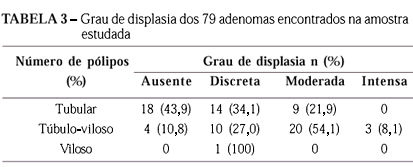Background - Magnification colonoscopy and contrast chromoscopy with indigo carmine dye solution have been used to differentiate neoplastic polyps (adenomas and adenocarcinomas) from non-neoplastic (hyperplastic, inflammatory, juvenile) in an attempt to obviate endoscopic polypectomy. On the other hand, little published information exists concerning conventional video colonoscopes and chromoscopy for polyp histology prediction. Aim - To assess usefullness of conventional video colonoscopes and contrast chromoscopy with indigo carmine solution for differential diagnosis of colon polyps. Methods - In a routine colonoscopy series, we performed chromoscopy with conventional video colonoscopes before endoscopic excision of detected polyps. If a sulcus pattern was observed on the surface of the lesion, it was classified as neoplastic. Polyps were classified as non-neoplastic if no sulcus was detected on its surface. These observations were then compared with histology. Results - In the study period (18 months), we detected 133 polyps in 53 patients. We were able to compare results of histology and chromoscopy in 126 lesions. The sensitivity, specificity, diagnostic accuracy, negative predictive value, and positive predictive value were 56,4%, 79,2%, 65,1%, 52,8%, and 81,5%, respectively. Conclusion - On the base of the presented data, we concluded that conventional video colonoscopes and contrast chromoscopy with indigo carmine solution is not a good technique for differential diagnosis of colon polyps.
Colonoscopy; Colorectal neoplasms; Indigotindisulfonate sodium




